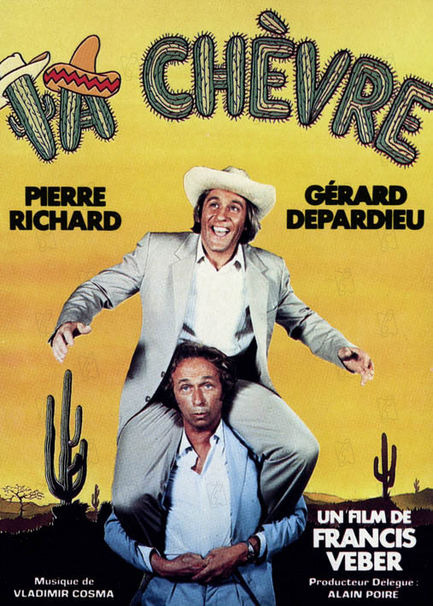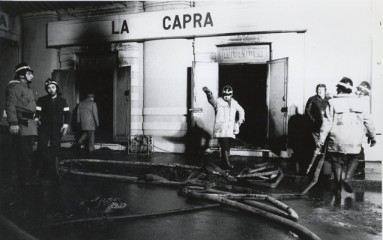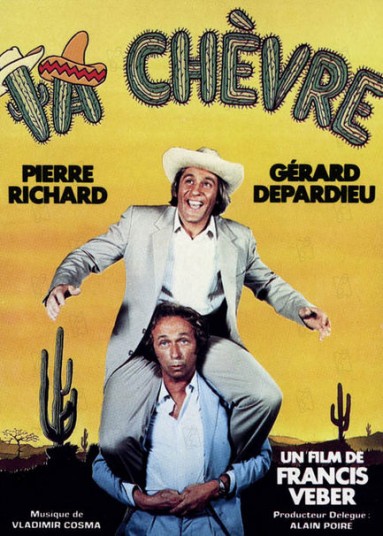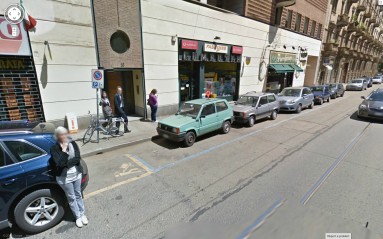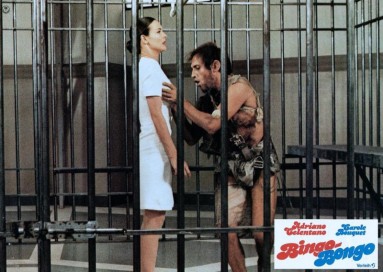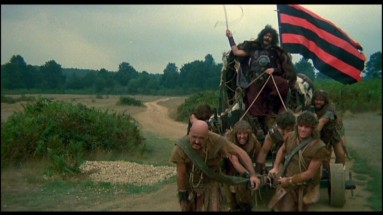[I'm in the final months of writing my dissertation project, which is about Italian cinema, circulation, and communist thought through the "Creeping '70s." As I'll be subtracting from the world a bit while finishing this up, I'll share excerpts for those interested. For those not, sorry - things more likely to inspire John Mayer trolls will return shortly, as will the materials of my next big historical project: on sabotage.]
On February 13, 1983, a second-run theater in Turin called Cinema Statuto - so named for its proximity to the nearby Piazza Statuto, itself named in memory of the Statuto Albertino, the Albertino Statute, of 1848 with which Charles Albert of Sardinia surrendered to the Kingdom of Sardinia and which would become the basis of the Italian constitution until 1948 - was showing The Goat (La Chevre, dir. Francis Veber, 1981), a France-Mexico-Malta co-produced comedy. The film, which stars Gerard Depardieu and Pierre Richard, was far from a hot commodity, having been released in France two years prior to little fanfare, albeit enough commercial success to merit casting the comic duo together two more times in similar films. In addition, given that it debuted outside of France in the spring of 1982 and that Cinema Statuto was a second-run (seconda visione) theater, the print watched that night must have been a bit tired, scratched, and worn from making the rounds of Italian prima visione (first-run) theaters.
By all accounts, The Goat is far from a pinnacle of comedy, Gallic or otherwise, even if its conceit has its share of screwball charm: a rich businessman’s daughter is missing in Mexico, and because she is so disaster-prone, a private detective sends another cosmically unlucky guy on her trail, like some cursed magnet of ill-fortune… However, it’s that very plot point that retroactively made the film a selection of extremely poor taste. Because that night, the cinema caught fire. 64 people died trapped inside, not from the flames themselves but from the poisonous hydrogen cyanide gas generated, in a truly vicious instance of classic irony, by the allegedly fire-resistant fabric of the chairs.
This was the worst disaster in Turinese history since the second World War, killing children as young as 7 and leaving 9 others orphaned. It carries an uncanny sense of historical disjuncture, as though a fire from 7 decades prior, back when cinema blazes were one of the main determinants of theater construction and deterrents of attendance[1], had come untethered from its moment, only to wind up on the other end of the cinematic century where spectatorship was no longer growing but hemorrhaging. The owner of the Statuto landed in jail for 10 years on manslaughter charges, and the theater was left charred and abandoned for 13 years.
Today, it is no longer there, because in1996, it was torn down to make room for a condominium and a computer store, those twin nodes of post-public spectatorship. One is hard pressed not to take the Statuto fire and its aftermath as some toxic swansong, an ugly material figuration of the trajectory followed by that peculiar relation between capital, city, and history long articulated by the cinema, not as a visual medium but as a social practice once widely integrated into rhythms and routes of everyday life.
Indeed, while Italian public filmgoing persisted solidly, and new theaters continued to be built, until the middle of the ‘70s, markedly longer than any other country in Western Europe or North America, it moved from “immobilism” of viewership, as Barbara Corsi puts it, to unraveling with striking velocity in the second half of the decade. National ticket sales only dropped from 525 million per year in 1970 to 513 million in 1975, a minor change compared with the full flight from public theaters to follow: down to 373 million in 1977, 276 million in 1979, and, by 1985, 123 million (Corsi 124). In the same years, as a response to, and subsequent further cause of, falling attendance, ticket costs ballooned, up from 706 lire per ticket in 1975 to 4,064 lire in 1985.[2] This collapse of a distinct form of social, spatial, and economic experience carried an undeniable class orientation, because the drop in cinema-going was far more extreme in proletarian communities, especially amongst working class women. By 1977, only 29% of what the DOXA report calls la classe inferiore (the lower class) had gone to the cinema even once in the 6 months prior to the survey, while amongst women from that “class,” it was only 17% (DOXA 18). The demise of the cinema - as that experience, not as the existence of films - must therefore be read, at least in part, as the decomposition of a particularly proletarian relation to the spheres of city, factory, and home, a relation which I argue de facto provides the materials for a critical grasp of those sphere’s deep entanglement, entirely regardless of whether or not a specific film deals with them as content or is generically coded as a “critical” or “engaged” (cinema d’impegno) film.
The sense of decomposition was not restricted to the act or frequency of cinema going, as the transition from the mid-’70s to the mid-’80s also saw shifts in the film industry itself that both commentators and audiences were to lament under the signs of “decline,” “decadence,” and “degeneration,” even if their reasons had more to do with a distaste for what I call unplanned cinema and its uniquely frantic form of repetition - the type, for example, that would generate 110 extremely similar poliziotteschi (cop films) in the scant space of 6 years. But Italian cultural fixation on the idea of a “crisis of cinema” aside[3], those lamentations touched on a historical apex of real transformations that had been going on since the Corona laws of 1965 annulled the prior Andreotti laws (1949) that had structured the development of a national film industry after the war.
It is unsurprising, for instance, that The Goat, while a coproduction, had no Italian involvement: Italian co-productions dropped from 24 in 1978 to just 7 by 1985. Moreover, those same years of accelerated decrease in attendance also saw the slow Italian adoption of a “saturation selling” model, predicated on the simultaneous release of many prints of a single film that would remain on market for a short period of time, as opposed to the previous run/visione system in which a smaller number of prints were shown over the course of years (on average for 2.5), working their way out from metropolitan centers to the terza vizione of the urban periphery and the parochial cinemas of the countrysides. The result of this shift was the crushing of the little exhibitors and local theaters, meaning that more and more people had to travel greater distance to find a cinema, which, for the most part, they simply did not do.
If they did, the fare on offer by the time Cinema Statuto went up in deadly smoke indexed another shift in the works through the second half of the ‘70s and cresting by the mid ‘80s: the rise of the producer-dominated system, largely predicated upon a single star model of films. The biggest producer in this period, one whose mention still conjures eyerolls and sighs from many Italian filmgoers, was Mario Cecchi Gori, who had been in the industry for decades and behind much-vaunted films like Dino Risi’s Il sorpasso and I mostri. By the ‘80s, though, he was better known for mining well-trod ground by simply shift locations, like relocating the Delitto a… [Crime at…] camp cop films to a Formula One race (Delitto in formula Uno, 1984) and “remaking” recent Turkish comedies, without permission, to cut script costs. He was also known for holding stars like Adriano Celentano - an entertainer in the Jerry Lewis sense of cross-platform breadth and with only slightly less manic goofiness - under contract to build cheap, derivative films around their presence and box office pull. In most instances, he combined the two habits: Bingo Bongo (1982, directed by ex-giant of neorealism Pasquale Festa Campanile), the blatant rip-off of the 1975 Turkish comedy Hanzo (1975), consists largely of Celentano grunting and throwing bananas as an Italian sub-Tarzan who becomes the ambassador of all animals to humankind and who will - of course - get the girl, once she declares her love to him in “ape.”
Another actor, Diego Abatantuono, the star of low-brow comedies in which the Milan-born Celentano played a nearly incomprehensible terrone (a perjorative term for a Southerner), clarified the Cecchi Gori logic: “They had the idea that everything I was doing had to go well. That is, once my involvement was assured, they let everything else drop” (Detassis 30, my translation). For the film whose production Abatantuono is describing, the sublimely stupid and truly funny barbarian slapstick/peplum [sword and sandal] satire Attila the scourge of God (Attila flagello di Dio, 1982, dir. Franco Castellano and produced by Cecchi Gori), in which A.C. Milano flags fly from the back of slave-drawn carts, “letting everything else drop” meant that the crew had to kill an escaped stunt tiger to keep it from eating them, because cost-cutting kept them from having the proper equipment to capture it.
For the films of of ‘75-’85 more broadly, it meant audiences could not help but see through the thin ploy. Dead tiger or no, the jittery European and national economy of cinema on the eve of video was laid unmistakably bare for its viewers through bald-faced exploitation of the star system and wholly unveiled repetition of successful formulae. As one respondent to the 1977 “sociological” inquiry of the Doxa Institute put it, “Back then, the cinema was healthy and prospering, whereas now it is declining; we can say that the cinema now has just occasional flashes whereas before it had production at a good level… the dead occasionally twitch and so it goes with the cinema…” (Doxa 26-27).
As with increased ticket prices, the solution - do it again, faster, and, as Corsi riffs off Sergio Leone it in her study’s title, con qualche dollari di meno (with a few dollars less) - was only to further dampen box office returns.
Intense exploitation of characters or successful filone; serial production; a policy of low cost (except for the pay of the protagonist, there was a zeroing out of the all the other professional contributions which contribute to the quality of the film); a scope restricted to the national market in terms of the creation and destination of the product; the aim of recuperating short-term capital with a fast consumption and no long-term planning [pianificazione a lungo termine]: these became the dominant parameters of the Italian film industry in the decade from 1975-1985 […] if to this is added the new possibility of presale of television rights, one understands how production underwent a total qualitative degeneration. (ibid 333-334, my translation)
Yet what should be clear and remains perennially hidden in the accusations of decline, decadence, and worsening is how these conditions were not qualitatively new: they had been the basic structure of the fast, very cheap, and self-cannibalizing filone cycles of decentralized film production that, from the late ‘60s on, had been providing Italy’s proletarian theaters with car chases, sexy schoolteachers, dialect humor, rogue cops, fart noises, and an abundance of cannibals.
This must, then, be taken as a total movement of degeneration, in the technical sense, though not because the good old days of neorealism were long gone or because one preferred co-productions or films designed to circulate beyond terza vizione theaters. Rather, glancing back at those years with a double eye to the histories in the movies, on the streets, and especially the muddy ground between them (i.e. “out of the frame”), we can grasp how the generative coherence of the cinema industry and its planned sustainability came properly undone, in the same years that audiences were priced out of tickets and no longer had neighborhood theaters.
These were also, and far from incidentally, the same years when the Italian myth of productivism and an institutionally mediated relation between labor and capital fully broke down. In that collapse and like the relation of city and cinema, it made clear how much that rapport had always depended on what was outside the factory, in the home, after the demonstration, in the background, and off-screen.[4]
?
[1] For an exhaustive and compelling study of this in the American context, see Rhodes, Gary D. The Perils of Moviegoing in America, 1896-1950. New York, NY: Continuum International Pub. Group, 2012.
[2] Those are just the median prices across the industry: in prima visione theaters, it rose as fast as 24% from season to season (DOXA 45).
[3] On this tendency, see: O’Rawe, Catherine (2008) ‘I padri e i maestri’: genre, auteurs and absences in Italian film studies’, Italian Studies 63(2): 173–94.
[4] To speak of the creeping ‘70s as a “revolutionary” time would miss the point. There was no revolution, either in the expected sense or in that of the concept underpinning the notation: a reversal or turning that keeps a basic arrangement, just switches what’s in front or who’s on top. What there in those years were many small insurrections, disruptions, and refusals that, when articulated, make up the long creeping sequence.
